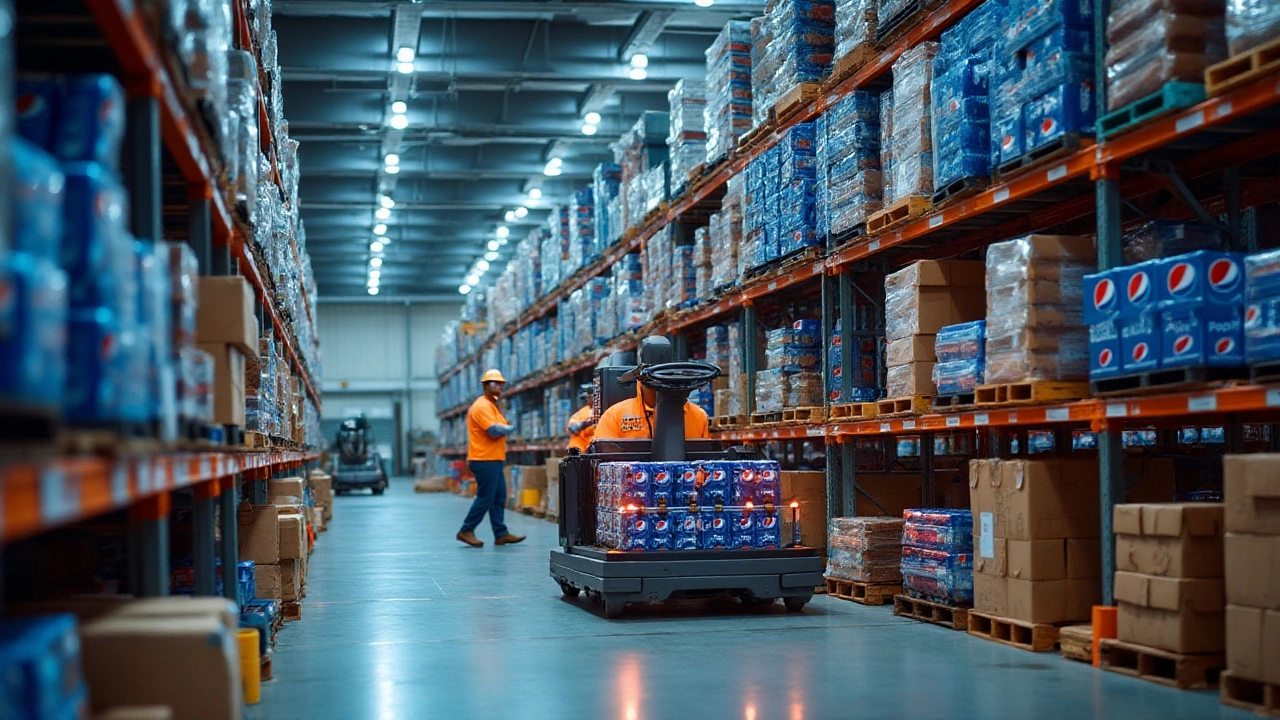In the fast-moving world of consumer goods, companies like PepsiCo rely heavily on robust logistics to meet global demand. At the heart of this system lies their Warehouse Management System, a critical tool that ensures smooth operations across the supply chain. But what exactly does PepsiCo use to keep their processes nimble and efficient?
Exploring their choice of Warehouse Management System sheds light on how it supports large-scale inventory handling while maintaining flexibility. These systems go beyond mere inventory tracking; they orchestrate a symphony of logistical tasks that make sure products are in the right place at the right time. From sophisticated software features to practical implementation, understanding PepsiCo’s approach provides valuable lessons for any business looking to optimize its warehousing strategy.
- The Role of WMS in PepsiCo's Supply Chain
- Key Features of PepsiCo’s Preferred WMS
- Impact on Operational Efficiency and Cost Savings
- Challenges in Implementing a WMS
- Future of Warehouse Management at PepsiCo
The Role of WMS in PepsiCo's Supply Chain
In the bustling operations of PepsiCo, a company renowned for its iconic brands and global reach, maintaining a fluid and responsive supply chain is paramount. At the core of this supply chain is the Warehouse Management System (WMS), which acts like a conductor orchestrating a vast array of complex processes. By intelligently managing inventory, the WMS enables PepsiCo to minimize waste and maximize efficiency, assuring that every beverage and snack reaches its destination fresh and in time. This system doesn’t just track stock; it closely monitors distribution and production milestones, aligning them with consumer demand across multiple markets worldwide.
For PepsiCo, the deployment of such a sophisticated WMS has been a game-changer. It seamlessly integrates with their existing systems, including Enterprise Resource Planning (ERP) and Transportation Management Systems (TMS), providing a cohesive overview of their logistics operations. This integration facilitates real-time data exchange, enabling swift decision-making at every level of the supply chain. Moreover, by leveraging these insights, PepsiCo enhances the customer experience by ensuring product availability and minimizing delays. Efficiency gains are not merely reflected in faster processes but also in significant cost savings, which can be reinvested in innovation and brand growth. According to a report by Supply Chain Dive, 'an optimized WMS can reduce warehouse costs by up to 20% while boosting inventory accuracy to 99%'.
Another essential aspect is the role of technology in streamlining PepsiCo’s logistics. Advanced analytics and machine learning capabilities within the WMS allow for predictive modeling, anticipating potential disruptions before they occur. This predictive power is invaluable, particularly when battling challenges such as fluctuating demand or unforeseen supply chain disruptions. Such foresight ensures PepsiCo can adapt strategies promptly, maintaining a competitive edge.
"Adopting an advanced WMS allows PepsiCo to turn data into actionable insights, transforming challenges into opportunities," said an industry analyst at Gartner.This adaptability is crucial in a market landscape where agility often dictates leadership. Furthermore, the modern WMS at PepsiCo incorporates automated workflows, reducing manual handling, and thereby decreasing the risk of error, which is vital for maintaining the high-quality standards synonymous with their brands.
Key Features of PepsiCo’s Preferred WMS
PepsiCo, as a titan in the food and beverage sector, employs a sophisticated Warehouse Management System (WMS) that underpins its logistical prowess. One of the standout features of PepsiCo’s WMS is its robust inventory management capability. This system not only tracks stock levels in real time but also provides insights into inventory turnover rates and shelf-life predictions, vital for perishable goods. The combination of real-time data and predictive analytics ensures that products move efficiently from production to consumer hands. Such a setup minimizes waste and loss, aligning with PepsiCo’s sustainability goals.
Integration is another cornerstone of PepsiCo’s WMS. The system seamlessly interfaces with the company's existing Enterprise Resource Planning (ERP) software. This means data flows effortlessly between departments, providing a unified view of operations. A tightly integrated system boosts coordination across sales, production, and distribution, which is crucial for managing the colossal supply chain. With real-time data visibility, teams can make informed decisions quickly, further enhancing efficiency.
Advanced automation features within PepsiCo’s WMS are game-changers. Automated picking, packing, and sorting are achieved using a blend of robotics and artificial intelligence. This not only accelerates the process but also drastically reduces errors that can occur with manual operations. PepsiCo leverages voice-directed technology for warehouse tasks, which has been shown to increase worker productivity significantly. According to a tech study, voice-guided systems can improve order accuracy by up to 99%, a statistic that underscores the value of such technology in high-volume environments.
PepsiCo values flexibility in its operations, and their WMS reflects this. The system supports multi-channel distribution, allowing seamless routing of products across retail, wholesale, and direct-to-consumer pathways. This adaptability ensures that PepsiCo remains responsive to changing market demands and consumer preferences. During seasonal peaks, the system can pivot quickly to accommodate higher order volumes without compromising on service levels.
Security features in PepsiCo’s WMS shouldn't be overlooked. The system includes robust access controls ensuring that sensitive data remains protected. With rising concerns around data breaches, implementing such features is essential for safeguarding corporate and consumer information. PepsiCo’s commitment to data security reflects broader trends in logistics, where technology must balance innovation with privacy concerns.
The WMS is also designed with scalability in mind, supporting PepsiCo’s continuous growth. As the company expands, the system can be configured to new warehouses quickly, ensuring that each facility operates with the same level of efficiency and control. This scalability means PepsiCo can enter new markets or increase capacity without disruptive overhauls. Such foresight in design ensures that PepsiCo's warehousing capabilities will keep pace with its ever-growing ambitions.

Impact on Operational Efficiency and Cost Savings
For a company as large and dynamic as PepsiCo, every decision—whether on the factory floor or in the back offices—demands precision and foresight. The implementation of a robust Warehouse Management System (WMS) has been a pivotal game-changer for their operations. With these systems, PepsiCo gains more than just logistical capabilities; they secure operational efficiency that reaches every part of their supply chain. Imagine a system that not only tracks but anticipates needs and adjusts resources accordingly. This is what their WMS provides—a real-time arsenal for tackling the unpredictabilities of global logistics.
The concept of real-time data is crucial here. PepsiCo's WMS allows them to manage inventory at lightning speed, turning bottlenecks into ephemeral challenges. This agility leads to significant cost savings. For instance, minimizing storage costs is achievable through the precise timing of product moves, ensuring warehouse space is maximized. These savings are not merely theoretical. In fact, studies highlight how a state-of-the-art WMS can reduce inventory carrying costs by up to 25%. This aspect alone marks a tremendous fiscal advantage for any industry leader seeking to stay on top.
Efficiency isn't just about numbers; it's about enhancing the human element as well. By automating complex processes, PepsiCo's workforce can shift their focus from repetitive tasks to strategic decision-making, which in turn drives motivation and productivity. The continuous feedback loop created by an effective WMS also cuts down on errors significantly—some estimates suggest a reduction by as much as 80% in error rates. This minimizes the costly consequences of wrong shipments, returns, and dissatisfied customers.
According to an insightful study by the Harvard Business Review, ‘Companies that integrate technology with operations witness a surge in efficiency that translates directly to the bottom line.'
Moreover, the environmental aspect should not be overlooked. By optimizing routes and delivery schedules, emissions are lessened, contributing positively to PepsiCo's sustainability commitments. The ripple effect here extends beyond just cost—it reshapes their public and consumer relationships, paving the path for long-term growth. Efficiency and economics are intertwined in the world of PepsiCo's WMS.
In an environment that's constantly evolving, staying agile and cost-efficient is a non-negotiable. PepsiCo's selection of a nimble and adaptable WMS aligns seamlessly with their strategy to remain ahead of the competitive curve. By ensuring their operations are continually lean and efficient, they protect their global foothold while acting as responsible stewards of the environment and the economy.
Challenges in Implementing a WMS
Embarking on the journey to implement a Warehouse Management System, especially for a giant like PepsiCo, brings along a series of challenges that can be quite daunting. The initial hurdle is the integration of the WMS with existing systems. Companies often rely on legacy systems that have been the backbone of their operations for years. The transition to a modern WMS requires these systems to talk to each other seamlessly. This is not just a technical challenge but a strategic one, needing careful planning and execution to avoid disruptions in operations.
Data migration is another significant concern. Moving vast amounts of data from old systems into a new WMS can be tricky. Companies need to ensure that the data is clean and organized to be used effectively. Poor data migration can lead to errors and inefficiencies in the system, which can affect the entire supply chain. It's crucial to conduct thorough audits and tests during this phase to ensure a smooth transition.
"A successful WMS implementation requires a fine balance of managing technology, people, and processes," says Alan Winters, an industry expert in logistics software.
Training employees is also a major task in WMS implementation. With new technology comes the need for users to adapt to new processes. Training must be thorough and comprehensive to ensure that employees are comfortable with the new system. It should cater not just to the technical aspects but also emphasize on how this system can make their daily tasks easier and more efficient.
Resistance to change can pose a big obstacle too. Employees and management might be attached to old processes, wary of the uncertainty that new systems bring. It's essential to communicate the benefits effectively and involve them in the change management process. By demonstrating how the WMS will improve operations and make their lives easier, businesses can gain their buy-in and support.
Cost Implications and Planning
The financial implications of implementing a WMS are non-trivial. The investment goes beyond the initial costs of the software itself. Businesses must account for additional expenses related to hardware upgrades, employee training, and ongoing maintenance. It's a strategic investment that requires detailed cost-benefit analyses and long-term financial planning. PepsiCo likely evaluates return on investment scenarios to justify such an undertaking.
Customization and scalability are other factors that require attention. A WMS needs to be flexible enough to adapt to the company's specific needs and robust enough to handle future growth. Balancing customization with standardization can prevent future headaches. Companies must strike the right balance to ensure the system addresses current challenges while being simple enough to maintain easily.
Long-term Vision and Future Proofing
The future of warehouse management is about embracing new technologies and trends, including IoT, AI, and robotics. PepsiCo's implementation of a new WMS must take into account these technological advancements to remain competitive in the long run. It's not just about solving today's problems but also preparing for the needs of tomorrow. Planning with future scalability in mind ensures the company remains agile and adaptive to an ever-changing market.
The challenges in implementing a WMS are multifaceted, demanding a blend of technical expertise, strategic foresight, and human-centric approaches. Overcoming these hurdles can empower a company like PepsiCo to harness the full potential of a robust WMS, ultimately driving efficiency, cost savings, and customer satisfaction.

Future of Warehouse Management at PepsiCo
The future of warehouse management at PepsiCo is poised to evolve in intriguing ways, reflecting wider trends in technology and environmental responsibility. As one of the giants in the consumer goods industry, PepsiCo is expected to leverage cutting-edge advancements to maintain its competitive edge. A likely area of development includes the integration of AI and machine learning to further enhance their Warehouse Management System capabilities. This shift towards automation doesn't just mean efficiency; it means empowering the workforce by reducing repetitive tasks, allowing them to focus on more strategic initiatives. The industry has observed a trend where companies are aiming to deploy predictive analytics, something PepsiCo might explore to anticipate stock needs and orders better than ever before.
There’s also an increasing focus on achieving sustainability within warehouse management practices. PepsiCo, known for its commitment to sustainability, is likely to innovate in areas such as energy-efficient systems and reducing carbon footprints in warehouses. Emerging IoT devices offer real-time monitoring of environmental conditions, ensuring products are stored in optimal climates, thereby reducing wastage due to spoilage. This synergy between technology and sustainability can align with PepsiCo’s objectives. A report from the World Economic Forum anticipates that by embracing next-gen tech solutions, companies can lower operational costs while also achieving greener goals. As PepsiCo aligns with these new-age determinants, it's not just about staying relevant but leading by example in the supply chain sector.
Digitization will continue to play a significant role, with innovators in logistics stressing the critical nature of blockchain for strengthening transparency across supply chains. By potentially adopting blockchain within their WMS, PepsiCo could enhance traceability and security in their logistics, benefiting not only the company but also consumers who demand greater accountability in food sourcing. This move could also mitigate risks associated with data breaches and lost inventory, ensuring smooth operations.
"Digital transformation is not an option, it’s a necessity," shared an expert from the Supply Chain Management Journal. This quote encapsulates the spirit with which companies must approach future challenges. Embracing such transitions will place PepsiCo at the forefront of supply chain management innovations.
To accommodate these developments, larger and more sophisticated warehouse facilities might emerge, equipped to handle increased automation and tech integration. The question remains about the human element; PepsiCo may focus on upskilling their workforce to manage and work alongside these technological advancements, promoting a culture of continuous learning. Training programs could pivot towards integrating digital tools, ensuring employees are adept with these new systems. KPI (Key Performance Indicators) will likely be redefined to measure not just productivity but also innovation and collaborative efficacy.
As we peer into the crystal ball, a thoughtful forecast suggests PepsiCo will continue to intertwine innovation with sustainability, employing a smart blend of AI, IoT, and possibly blockchain solutions. They might also forge collaborations with tech startups to remain agile and responsive to changing market dynamics. The commitment to not just keeping pace but setting it, ensures the company’s resilience amid evolving consumer preferences and logistical demands. While speculation about the future can paint varied pictures, PepsiCo's proactive approach in adopting these futuristic tools and strategies will likely dictate the direction of their warehouse management practices, contributing to a more connected and sustainable ecosystem.





